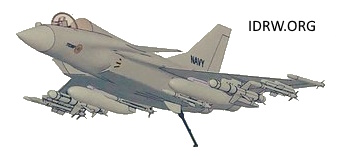SOURCE: AFI


The Twin Engine Deck-Based Fighter (TEDBF), an ambitious project spearheaded by India’s Aeronautical Development Agency (ADA) for the Indian Navy, is shaping up to be a formidable naval fighter. This indigenously designed aircraft is intended to replace India’s aging fleet of MiG-29K fighter jets and is being developed with the capability to operate from the Indian Navy’s aircraft carriers. While its design has stirred excitement for bearing a resemblance to the Rafale M—a proven naval fighter the Indian Navy is also acquiring—the TEDBF is a unique platform in its own right, tailored for India’s defense requirements and its naval operational environment. Here’s a closer look at what sets the TEDBF apart and how its design blends inspiration from the Rafale M with distinct indigenous enhancements.
The TEDBF’s design evolution showcases notable similarities with the Dassault Rafale M, particularly in terms of its frontal shape and canopy layout. The similarities give the TEDBF a sleek and aerodynamic look similar to the Rafale M, an aircraft known for its versatility and efficiency in carrier-based operations. However, the TEDBF features multiple distinguishing aspects that set it apart:
Distinctive DSI Intakes
The TEDBF employs Diverterless Supersonic Intakes (DSI), a feature not present in the Rafale M. DSI intakes improve aerodynamic performance by reducing drag and radar cross-section, thereby enhancing the aircraft’s stealth profile. These intakes are beneficial for stealth operations, as they contribute to reducing the aircraft’s radar signature, a priority in the TEDBF’s design that aims for a low-observable profile in radar-heavy maritime environments. DSI intakes are also easier to maintain and reduce the weight of the aircraft, making it a more efficient platform.
2. Cost Efficiency and Indigenous Value
While the Rafale M has earned its place as one of the most effective multirole fighters, it comes with a steep price tag, often exceeding $110 million per unit. In contrast, the TEDBF is being developed with cost efficiency in mind, aiming for a projected cost of less than $70 million per unit. This cost advantage makes TEDBF a highly attractive choice for the Indian Navy, allowing India to achieve greater fleet size and capability at a lower financial burden. It also aligns with the country’s self-reliance goal in defense, ensuring that critical technologies and designs are indigenous and subject to fewer export restrictions or reliance on foreign supply chains.
3. Advanced Features with Fifth-Generation Tech
The TEDBF is designed to incorporate technologies typically associated with fifth-generation fighters. This includes Active Electronically Scanned Array (AESA) radars, which provide enhanced target detection and tracking, and advanced stealth features that reduce its radar signature, allowing it to evade detection. Additionally, the TEDBF is expected to integrate cutting-edge avionics, digital warfare capabilities, and robust electronic countermeasures, making it adaptable to diverse threat scenarios. The Rafale M is undoubtedly advanced, but TEDBF’s incorporation of newer-generation tech gives it an edge in electronic warfare and survivability.
4. Reinforced Landing Gear for Carrier Operations
Carrier-based fighter operations demand stronger landing gear to withstand the high-impact landings unique to aircraft carriers. While the Rafale M was designed with reinforced landing gear for these operations, the TEDBF’s landing gear will be designed with a further emphasis on ruggedness and durability. It will also be optimized for short take-off and landing operations and will use advanced materials to support the stresses of repetitive carrier landings.
5. Foldable Wings and Catapult-Launch Compatibility
The TEDBF is being developed to include foldable wings, a feature critical for storage on aircraft carriers where space is limited. While the Rafale M has fixed wings, TEDBF’s foldable wings make it uniquely suited to the compact spaces of carrier hangars, facilitating more efficient storage and handling. Additionally, TEDBF’s wing design will be compatible with both ski-jump ramps and catapult-assisted take-off systems (CATOBAR), allowing it to operate from a wide variety of carrier decks, including India’s current and future aircraft carriers. This adaptability significantly enhances the operational flexibility of the TEDBF, ensuring that it can meet diverse deployment needs within India’s evolving naval capabilities.
While the TEDBF’s design may share aesthetic elements with the Rafale M, it is a distinctive, indigenously developed platform tailored to India’s specific operational requirements. Equipped with advanced stealth, flexible deployment options, and an affordable price point, the TEDBF is set to become a critical component of India’s maritime power projection. It embodies India’s vision of a self-reliant defense ecosystem, reflecting both modern design principles and indigenous ingenuity. With the TEDBF’s capabilities, the Indian Navy will be better prepared to navigate the complex security dynamics of the Indian Ocean Region, ensuring a more secure maritime environment for India and its allies.